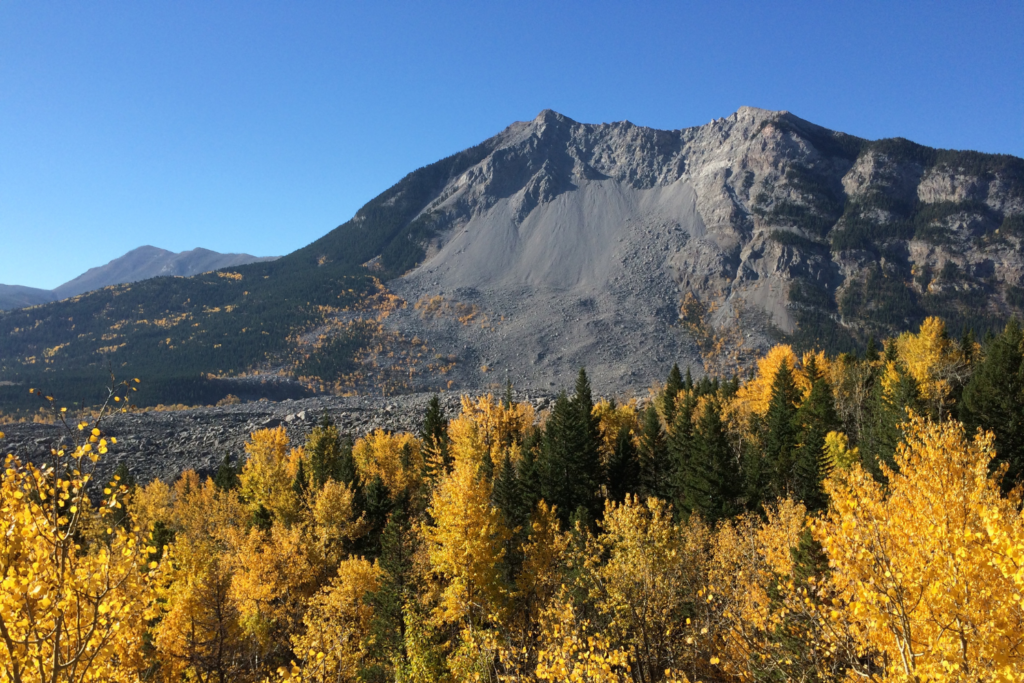January 12, 2024
Unearth the Many Secrets of this Remarkable Region
Nestled within the South Canadian Rockies lies a world of intriguing facts and historical gems waiting to be discovered. From cinematic wonders to breathtaking natural wonders, the region has much more to offer than meets the eye. Here are ten things you may not know about the area:
Hollywood Makes Movie Magic in the Region
From the iconic Brokeback Mountain to Ghostbusters: Afterlife, the South Canadian Rockies’ dramatic landscapes have played a starring role in many Hollywood productions, with the town of Fort Macleod featured in several blockbuster films. Let Him Go, starring Kevin Costner and Diane Lane, featured close-ups of downtown Fort Macleod, portraying North Dakota and Montana in the early 1960s. Interstellar’s dramatic dust storm scenes with Matthew McConaughey were also filmed in Fort Macleod, along with several scenes from HBO’s The Last of Us. It’s no wonder filmmakers are drawn to this stunning region, where the natural beauty of the South Canadian Rockies becomes a breathtaking backdrop for cinematic storytelling.
You Can Take Guided Tours in Lille, an Authentic Ghost Town
Since 1916, Lille, a former bustling mining village, has been frozen in time. With more than 400 residents employed in the mining industry, the town’s prosperity abruptly ended in 1912 due to rising coal production costs. What remains now is a ghost town that once thrived with a hotel, a general store, bakery, butcher shop, barber shops, a liquor store, a hospital, and a four-room schoolhouse. Remarkably, some of these structures still stand today, preserving a poignant piece of history. From May to October, you can join Uplift Adventures for guided historical tours of Lille.
Prohibition-Era Tales of Rum Running in Crowsnest Pass
During Alberta’s Prohibition era from 1916 to 1923, “rumrunners” secretly transported alcohol into the Crowsnest Pass, primarily to quench the thirst of hardworking miners. The “rumrunners” from this era could rival characters from a gangster movie plot, featuring figures like Emilio Picarriello, dubbed the “Bottle King of The Pass.” His accomplice Filumena Costanzo Lassandro faced execution for the murder of an Alberta Provincial Police Officer, and her story lives on through a namesake opera and even a film that premiered in 2003. You can dive deeper into this captivating history at the Crowsnest Museum and Archives before savouring prohibition-themed burgers at The Rumrunner Restaurant in Coleman.
You Can Explore Underground Mines in Bellevue
Don a miner’s helmet and lamp for an immersive journey 150 feet below the earth’s surface at the Bellevue Underground Mine. With experienced Heritage Interpreters as your guides, you’ll explore the mine’s inner workings, stepping back in time to discover the fascinating underground mining history of the Crowsnest Pass. The Bellevue Underground Mine offers a unique, historical experience, providing a glimpse into the life of a coal miner between 1903 and 1961. Tours are offered in the summer months and must be booked in advance.
Castle Provincial Park Was Originally Known as “A’saani” and Inhabited by the Kutenai and Piikani First Nations
The roots of Castle Provincial Park are intertwined with the history of the Kutenai and Piikani First Nations, whose connection to this land spans more than 10,000 years. They traditionally referred to the region as “A’saani,” signifying “sacred paint.” The Indigenous Peoples of the region traditionally inhabited and harmoniously coexisted with the land, utilising it for hunting, gathering firewood, foraging, and other essential aspects of their livelihood and cultures. The Kutenai and Piikani First Nations served as guides to the initial English settlers who arrived in the region in 1841.
The South Canadian Rockies is Home to One of Canada’s Deadliest Rockslides
In 1903, the serene town of Frank in the Crowsnest Pass was forever altered by the devastating Frank Slide, a catastrophic event that occurred due to geological instability, coal mining, and unique weather conditions. The mountain is still monitored by scientists to this day, and there’s a chance that another piece of Turtle Mountain may fall in the future. Long before European settlers arrived in the region, Indigenous Peoples called Turtle Mountain “the mountain that moves.” You can explore the history of Turtle Mountain at Frank Slide Interpretive Centre, where you can immerse yourself in the history, geology, and human stories of this monumental event.

The Famous Burmis Tree Survived Nearly 700 Years in Alberta
Nestled in the Crowsnest Pass, just a short drive from Frank Slide, the Burmis Tree, a remarkable Limber Pine, stands as one of Alberta’s most photographed marvels. These hardy trees, renowned for their ability to endure harsh conditions, have graced the landscape for centuries. Believed to have thrived for nearly 700 years before its passing in the late 1970s, the Burmis Tree now represents a cherished local emblem and an enchanting photographic subject, especially during a captivating sunset. Perched atop a gentle rise near the Crowsnest Highway, this resilient icon invites a brief stop to capture its enduring spirit.
Castle Mountain Has Had Many Names Since Settlers Arrived
It has had many names, but the same mountain still stands. Castle Mountain Provincial Park, originally known as “A’saani” by Indigenous Peoples, has always maintained an large presence in the region. In 1858, after settlers arrived, James Hector named it “Castle Mountain” for its striking castle-like appearance. It was renamed Mount Eisenhower in 1946 by Prime Minister Mackenzie King to honour Dwight D. Eisenhower, however, after community protests, it was restored to “Castle Mountain” in 1979. In 2017, Castle Provincial Park was officially established. The park safeguards 63,010 acres of land, including critical habitats for endangered plant species like the Limber Pine Tree. Today, the park offers a range of outdoor activities, including camping, hiking, and winter adventures, while preserving the natural beauty that spans its long history.
Alberta’s Great Train Robbery of 1920
The pages of South Canadian Rockies’ history witnessed “Alberta’s Great Train Robbery” on August 2, 1920, when three men robbed a passenger train near Coleman. The men robbed the conductor and passengers on the train for their valuables including pocket watches, cash and more. While one of the robbers managed to escape, the other two were apprehended five days later at the Bellevue Cafe following a fierce gunfight that tragically claimed the life of Corporal Bailey from the RCMP and one of the robbers. The last bandit made his way to Pincher Creek, where he too was ultimately captured, marking the end of a daring chapter in Alberta’s past.

Pincher Creek’s Name is Rooted in Discovery
The intriguing origin of Pincher Creek’s name can be traced to a chance discovery. In the area surrounding the town, a North West Mounted Police officer stumbled upon a pair of pincers, a specialized tool employed for grooming horses’ hooves, nestled in a nearby creek. This fascinating find gave rise to the town’s distinctive name, which was officially documented as a place name in 1880 within the Geographical Survey Report, commemorating the unique historical context from which it emerged.
The South Canadian Rockies offer a world of history and natural wonders waiting to be explored. So, pack your curiosity, bring your camera, and embark on your journey to discover these captivating stories for yourself!
The South Canadian Rockies offer a world of history and natural wonders waiting to be explored. So, pack your curiosity, bring your camera, and embark on your journey to discover these captivating stories for yourself!






